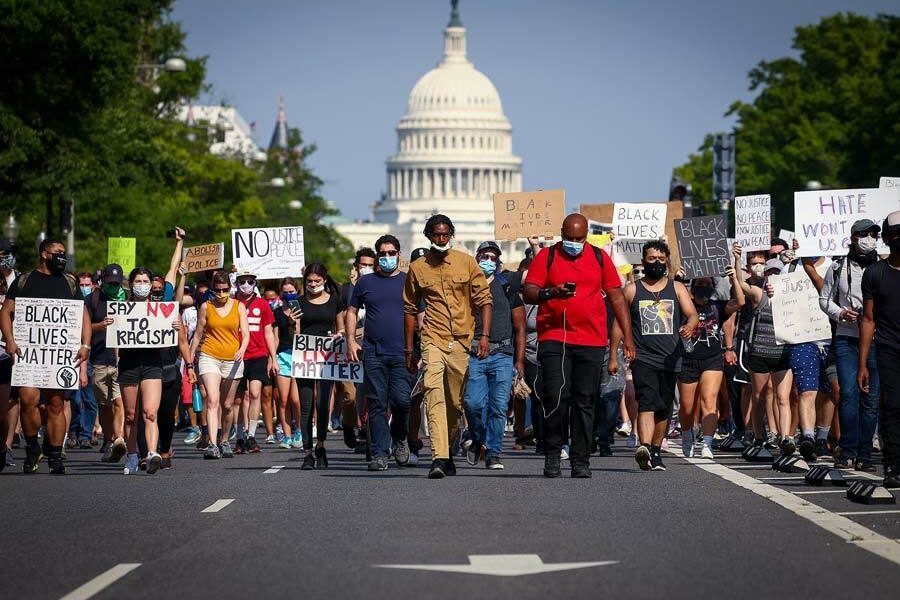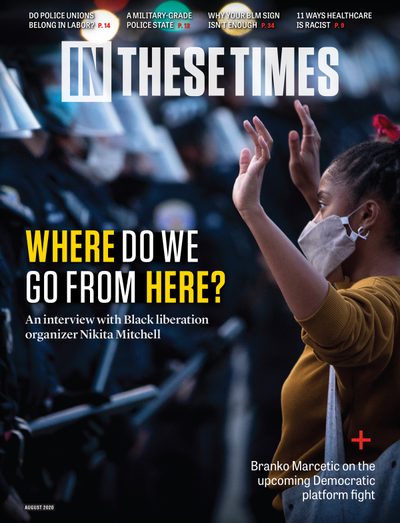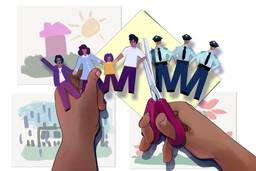“We Are On the Cusp of Something Great”: A Black Liberation Organizer on Next Steps for the Movement
An interview with Nikita Mitchell
Nikita Mitchell

Since the nation erupted after the May 25 police killing of George Floyd, Black organizers and community members have been working around the clock to channel mass protests into tangible victories. Nikita Mitchell, 26, is national coordinator of The Rising Majority, formed in 2017 by the Movement for Black Lives, a coalition that includes Black Lives Matter. Rising Majority is led by Black people and people of color, and brings social movements together in an anti-racist, anti-capitalist Left for radical democracy. Nikita talked with In These Times in late June from Oakland, Calif., after another of many all-nighters. She shared what this moment feels like after years of organizing, The Rising Majority’s plan for a “hot summer,” how to sustain pressure for radical change and where Biden and Trump fit in.
A lot of organizers are telling me they are exhausted trying to keep up — the movement, the pandemic. How do you keep going?
NM: As someone who has been in movement communities for a long time, it’s deeply inspiring to me to see this level of analysis, dreaming, imagination. We are seeing an acceleration of public consciousness not just in defense of Black lives — I think a lot of that foundation happened in 2013, 2014, 2015 — but the need to transform systems at the root. For me, that’s energizing. So is the level of mobilization — across the country, globally, out of Oakland. We are on the cusp of something great, something historic. It keeps me going when I’m tired.
How long have you been organizing?
NM: I can’t talk about the movement without talking about my grandmother, Dolores Bosley. She is from Bastrop, Louisiana. She grew up in a home for folks who worked in a cotton mill and for sharecroppers. She wanted me to understand two things. One, the legacy of Black people. Two, that I am inherently valuable as a person. I attribute the seeds of my consciousness to my grandmother.
My way into movements was through educational justice work in high school, at 14, through a group called Youth Together. Ever since my family migrated to Oakland, Castlemont High School was the high school we all went to, in a historically Black, Latino and Polynesian community of deep poverty.
One day, they suspended 80 students for a cell phone policy — for cell phones dropping out of pockets, for walking with a phone. That made folks really angry. In addition, outside cops were brought in to deal with violence, with racial tensions, when we knew the solution was not policing. So we landed on the model of restorative justice. That campaign resulted in a citywide resolution to have restorative justice as the main model of harm reduction in schools.
I kept organizing in college. Union organizing with UNITE HERE solidified my commitment to long-term organizing. The thing that got me back into anti-police brutality work was the start of Black Lives Matter. I got a request, like a secret meeting, “Black people come to this location.” I knew Alicia Garza and a few other movement founders, and I showed up. That was the beginning of the BLM Bay Area chapter.
After years of organizing for Black lives, are you surprised by the new mass protests?
NM: A movement never dies. There are cycles: Moments where it’s really intense, moments of movement-building. So I’m not surprised. Consider the time and conditions: the convergence of Covid with the continued illegitimacy of our government. Trump and our government did not protect folks during Covid, but instead protected corporate interests. You also have police murdering Black folks. That felt like the snapping of a straw.
But I am excited by the level of mobilization. Dallas has been out for two weeks straight, Minneapolis for a month. I think about Black organizing projects in Oakland. They’ve been working on getting police out of schools for a long time, and they are on the precipice of winning.
Let’s talk about winning. What is winnable now?
NM: The demand to defund the police and fund the people has real traction. It’s not a new demand, but it has become a unified rallying cry. What it means is literally pulling all the funds from policing and moving that to programs that actually ensure community health.
For The Rising Majority, our platform is radical democracy — so it’s not enough to just move money from police to programs for the people. Community control is a key part of sustaining that shift. As the movement gets organized, community control and participatory budgeting become additional demands.
What kind of programs need investment?
NM: That’s a hard question — it requires the people. This is part of why participatory budgets are such a cool thing.
Personally, when I think about community safety and wellness, I think about quality jobs that don’t support capitalist interests — green jobs, collectives. A reimagining of what our economic system could look like. Counselors in schools. Making sure every young person has food. What if food and housing insecurity were not something which, every day, you have to wake up and navigate? Healthcare — Democrats talk about universal healthcare, but Covid-19 illuminated the real failures of our system.
Alternatives to policing — what excites you there?
NM: I now believe in transformative justice. Restorative justice is an important framework with useful tools, but it aims to get back to “normal.” For Black people, poor folks, queer folks, trans and nonbinary people, normal is still a site of violence.
Transformative justice asks: What actually needs to shift, so violence and harm for a particular person or community doesn’t remain possible in the same way?
A good friend of mine trained me on restorative justice growing up. His sister was murdered in the height of him talking about restorative justice. It would have been really easy for him to resort to violence, including the violence of locking the guy up. What he decided to do was create a restorative justice process.
This person’s mother came to meet with my friend’s mother. They had conversations about not just the crime, not just the violence, but how their children got to the place they’re in. They talked about family and stories and poverty, and housing insecurity, and how all of those things led up to the murder. My friend’s mother then went to meet the guy who murdered her daughter. After some time, they had a real conversation about the harm that was caused. Justice can’t happen outside the people directly affected.
None of that takes away the fact that her daughter was murdered, the sadness, the rage. What it did do was create an opening for justice in a way the current system would never allow.
What happened on the criminal justice side?
NM: You don’t really have a choice about the criminal justice system, unfortunately. He ended up going to prison, which — according to my friend — felt empty after the process they went through. My friend’s mother and this person had a relationship — a tenuous one, for sure, but a relationship — and so punishment felt empty and not about justice, for anyone. The system is still a site of terror and control. We need to reimagine how we deal with harm and say unapologetically that prisons are not the way to do that.
And that’s hard to hold, you know, for people talking about defunding the police — that, in a situation with no police and no prisons, justice will be more intimate. That feels difficult for me, as a survivor of sexual violence, to be like: How do I have a conversation about justice that looks someone directly in the eye? I go back to this all the time. What does it look like to take away these systems that aren’t set up for justice for anyone, and have a real community process?
A lot of these solutions are local, where much of the police budget is controlled. What do you see on a broader, national level?
NM: One key opportunity is the stimulus packages. In the middle of a pandemic where 125,000 folks have died and 33 million people lost jobs, the stimulus package earmarked $850 million to “public safety.” We know, for white supremacists and capitalists, that “public safety” means police budgets and ICE detention centers, when folks need Covid testing, rent cancellations and freezes, employment support. So a federal target for us is the stimulus packages coming up, as a place we can actually redirect funds to the people.
The second thing we’ve been talking is divestment from white supremacy, racial capitalism and anti-Blackness. Some of the analysis we’re working toward is how statesanctioned violence and terror are protected and enabled by the federal government. So let’s talk about defunding militarized forces domestically and abroad — because the function of those systems is ultimately to protect capital and white supremacy. And we understand Trump as a figurehead of this in this moment. For example, when Trump threatened to call in the military on protesters to defend property. As if that Target building is more important than a living, breathing soul.
Trump is not the first, but he is dangerous. So we’re also thinking about how to call out the illegitimacy of government in this moment. When we ask, “What does it mean to fund the people?” You understand that concept; I understand that concept; Trump will never understand. His vested interests put him against the people.
So are we talking about campaigning against Trump here?
NM: That’s a direct question! (laughs) The Rising Majority and the Movement for Black Lives are talking about mobilization that calls out Trump as the figurehead. We are unapologetic that he and his folks down the ballot need to go. And we’re clear we need to do that work within our ecosystem. What’s required to get Trump out is sustained mobilization, but sustained mobilization should not be just about getting him out. It’s clear we need a nationwide campaign to defund the police and to fund the people.
And then there’s Biden. (laughs) Oh, Biden. It’s not like Biden is that much better. Biden has similar interests to Trump, right? But he has a different game plan for which way to enact violence on our people. He’s a neoliberal candidate, and we have experienced the impact of neoliberalism.
What do you say to Biden’s police reform proposals: chokeholds, racial bias training, community policing?
NM: They are a disrespect to the people who lost people to police brutality. A disrespect to the people being brutally, brutally repressed by police. It’s a disrespect to say to people making a clear demand to defund, “We’re going to give you a reform!” If that is not neoliberalism… (laughs)
Biden’s going to try to give concessions to the people— some of which may seem like harm reduction because “now you won’t get choked out” — but a concession that does not actually transform the systems that enable violence is a concession our movement should question.
It’s a challenge. We’ve been sold a dream that the Civil Rights Act was a pinnacle; it’s not. How do we invest in a long-term, proactive struggle? Come Trump or Biden, that’s the work of movement.
How are movements engaging and educating all these new protesters?
NM: When the mobilizations really began heating up, The Rising Majority did a political education program. We had a virtual session with Angela Davis, Jamila Woods, N’Tanya Lee from LeftRoots, Kayla Reed from Action St. Louis, Karissa Lewis from Movement for Black Lives, Timmy Rose from Dissenters and Greisa Martínez Rosas from United We Dream. That teach-in had about 360,000 views, so I think folks are hungry to be out on the streets, to make meaning in this moment. Education is some of what this movement will be up to in the next few weeks.
How do we sustain pressure for change? Can street protests persist?
NM: We need a combination of tactics. We at The Rising Majority are calling for a “hot summer” of intense organizing. We also know folks will get tired: We need organizations to hold sustained energy for a long-term, proactive struggle.




